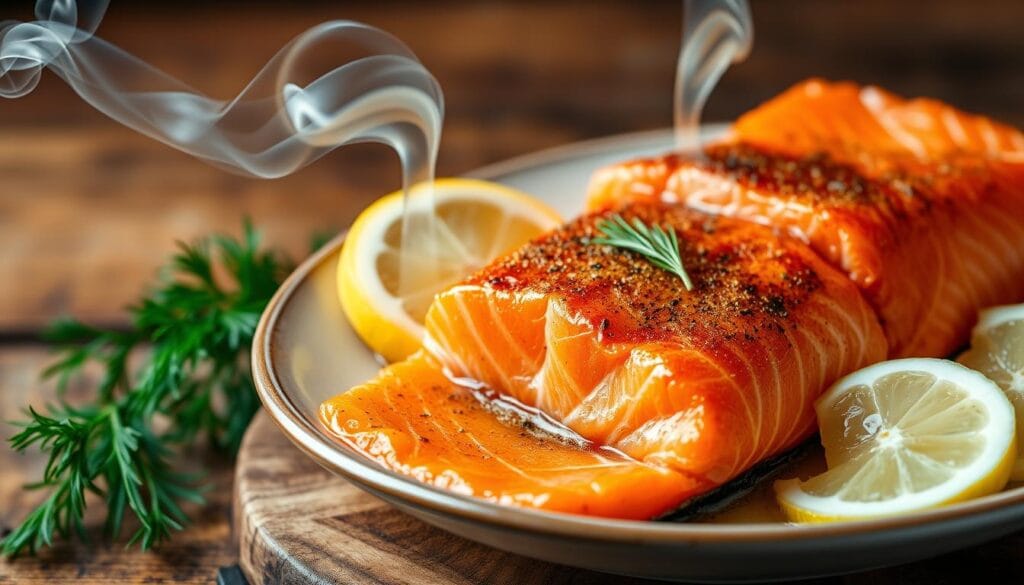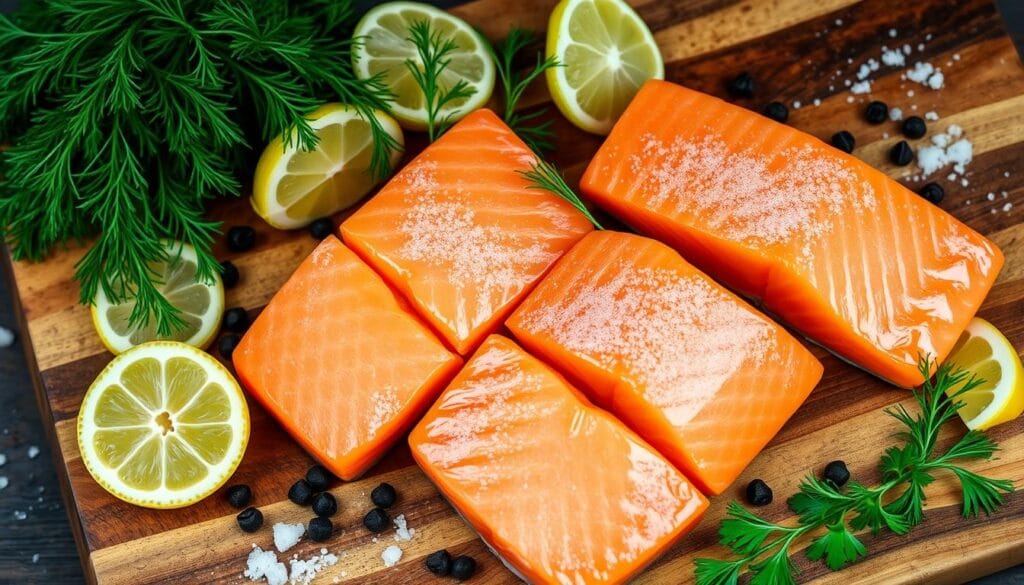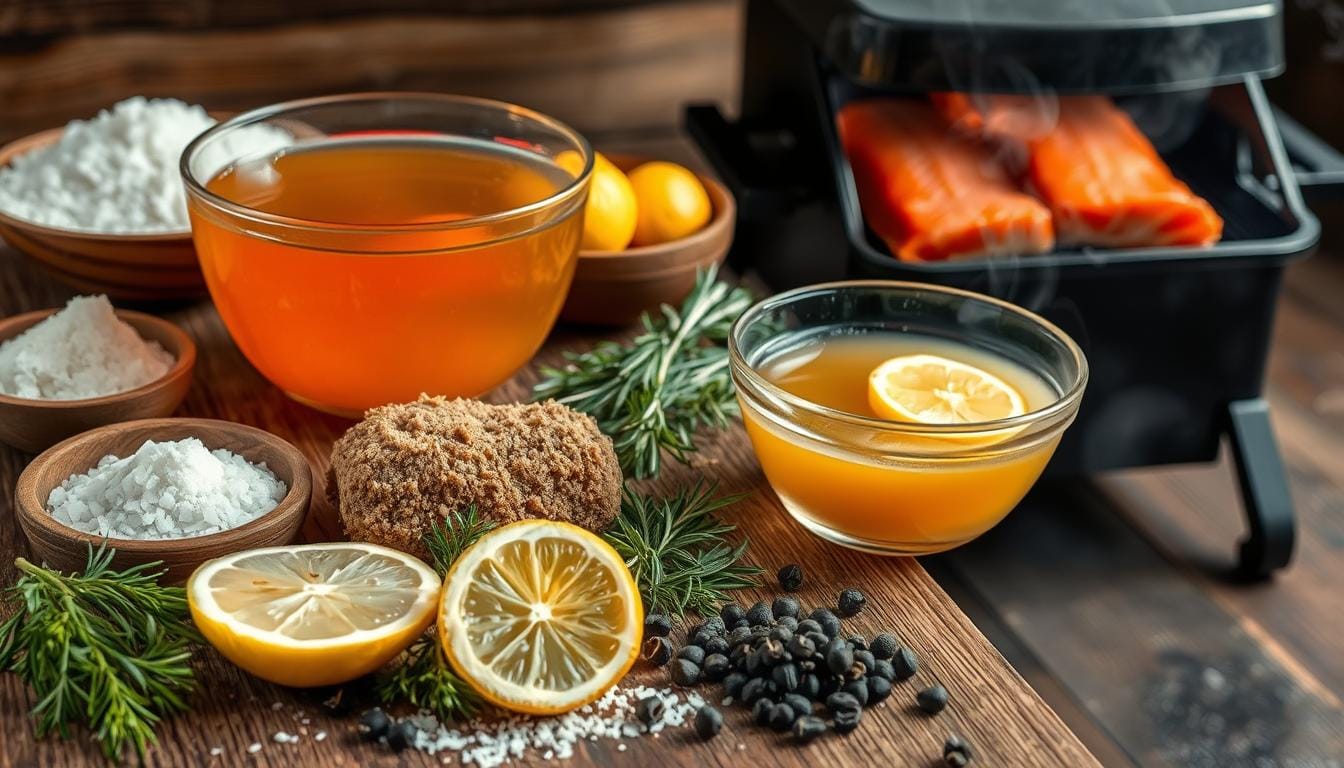Creating delicious Brine Recipe for Smoking Salmon. This guide will show you how to make a tasty brine. You’ll learn how to smoke salmon at home, making it tender and flavorful.
A good brine is key to perfect smoked salmon. You’ll need 1 gallon of water, 1 cup of kosher salt, 1 cup of white sugar, and 1 cup of brown sugar. This mix gives your salmon a nice balance of salty, sweet, and savory flavors. Feel free to add garlic, dill, or black pepper for extra taste.
Brining is important for flavor and texture. Brine your salmon for 12 to 36 hours, depending on its thickness. This ensures your salmon is moist and well-seasoned.
After brining, it’s time to smoke the salmon. Smoke it at 180°F (82°C) for 5 to 6 hours. This slow smoking makes the salmon tender inside and chewy outside.
Understanding Hot-Smoked vs Cold-Smoked Salmon
There are two main ways to smoke salmon: hot smoking and cold smoking. These methods differ in the smoking process. They also affect the flavor and texture of the salmon.
Hot Smoking Process and Temperature
Hot-smoked salmon is briefly brined and then cooked at about 225°F. This makes the salmon firmer and gives it a stronger smoky taste.
Benefits of Hot Smoking at Home
Hot smoking is easier for home cooks. It needs shorter cooking times and is simpler to control. The salmon should reach 150°F for safety and doneness.
Traditional Smoking Methods
Before modern refrigeration, traditional smoking was used to preserve salmon. Indigenous people in North America and Canada used these methods. They cured the fish for a long time and then smoked it at low temperatures for hours or days.
While traditional methods can be great, hot smoking is easier for home chefs. It allows for making delicious, flavorful smoked salmon.

“Hot smoked salmon is typically smoked above 120 degrees F, while cold smoking requires temperatures typically below 90 degrees F.”
Choosing the Best Salmon for Smoking for Your Brine Recipe for Salmon Smoking
Choosing the right salmon is key for smoking. Go for farm-raised Atlantic salmon or wild king (Chinook) salmon. They have the right fat content for smoking, making the final product rich and flavorful.
Farm-Raised vs. Wild Salmon Options
Farm-raised and wild salmon are both great for smoking. But they differ in some ways:
- Farm-Raised Atlantic Salmon: It has more fat, keeping the fish moist and tender when smoked.
- Wild King (Chinook) Salmon: It has a strong flavor and enough fat for smoking.
- Wild Sockeye Salmon: Not good for smoking because it’s too lean and can dry out.
- Coho Salmon: It’s a decent choice, but it has less fat than Atlantic or king salmon.
Quality Indicators When Buying Salmon
Look for these signs of quality when buying salmon:
- Flesh should be firm and shiny, without tears or spots.
- It should smell fresh and mild, not too fishy.
- It should be handled and stored properly, whether it’s fresh or frozen.
Optimal Fat Content Considerations
The best salmon for smoking has 12-15% fat. This fat helps keep the fish moist and adds a buttery texture. Both farm-raised Atlantic and wild king salmon fit this bill, making them the best salmon for smoking.

Essential Brine Recipe for Salmon Smoking
Making the perfect brine is crucial for delicious smoked salmon. The recipe mixes water, kosher salt, white sugar, brown sugar, and aromatic seasonings. A dry brine of salt and sugar is preferred for its simplicity and flavor.
Brining for about 5 hours is ideal. It seasons the salmon right and prevents over-salting. This step makes the salmon firmer and brings out its natural flavors, which pair well with smoky notes.
| Ingredient | Quantity |
|---|---|
| Water | 1 gallon |
| Kosher Salt | 1/2 cup |
| White Sugar | 1/2 cup |
| Brown Sugar | 1/4 cup |
| Black Pepper | 2-3 tablespoons |
| Garlic Powder | 2 teaspoons |
| Onion Powder | 2 teaspoons |
The dry brine method involves rubbing the salmon with a salt and sugar mix. Then, refrigerate it for 6-8 hours or overnight. This makes the salmon firm and flavorful. After brining, rinse the salmon under cold water and pat it dry before smoking.
“The key to a perfect smoked salmon brine is finding the right balance between salt, sugar, and aromatic seasonings. This essential recipe delivers unparalleled flavor and texture.”
The Science Behind Brining Salmon for Your Brine Recipe for Salmon Smoking
Brining salmon before smoking is key to better texture, flavor, and moisture. The science behind it is interesting and greatly affects the smoked salmon’s quality. Salt in the brine helps remove excess moisture and changes proteins, making the fish firmer and denser.
Sugar in the brine balances out the salt and helps the salmon brown and caramelize when smoked. This mix of salt and sugar also reduces albumin, the white protein that can appear during cooking.
Brining helps keep the salmon moist and flavorful. By understanding this science, you can make your smoked salmon perfect in texture, taste, and look.
| Brine Type | Brine Ratio | Brining Time |
|---|---|---|
| Dry Brine | ~1 tsp salt per small-to-medium salmon fillet | 15 minutes to overnight |
| Wet Brine | ~1 tbsp salt per 1 cup water | 30 minutes to 2 hours |
Choosing between dry brine or wet brine depends on what you like and what you want to achieve. Wet brining can stop albumin ooze by softening the salmon’s outer fibers. Dry brining gives a stronger flavor.
“Brining is a process that involves soaking meats in a solution of salt and water to enhance flavor, tenderness, and moisture content.”
Brining salmon before smoking is essential for a better final product. It’s all about the science behind it.
Preparing Your Salmon for the Brine Recipe for Salmon Smoking
Before you can enjoy the delightful flavors of smoked salmon, proper preparation is key. Start by trimming any excess belly fat from your salmon fillets. This will help ensure even brining and smoking. Next, use a pair of tweezers or a small, sharp knife to carefully remove any remaining pin bones.
Pin bones are easier to spot and remove when the salmon is very cold. So, consider placing the fillets in the refrigerator for a while before tackling this task.
For consistent brining and smoking, you may want to consider portioning larger salmon fillets into smaller, more manageable pieces. This will help the brine and smoke penetrate the fish evenly. Regardless of the size, make sure all your salmon fillets are at a consistent, refrigerator-cold temperature before submerging them in the brine.
Skin-on fillets are preferable, as the skin helps hold the fish together during the smoking process.
By taking the time to properly prepare your salmon, you’ll set the stage for a successful smoking experience and delicious results. With the right techniques, you’ll be well on your way to creating mouthwatering smoked salmon that’s worthy of a gourmet feast.
| Preparation Step | Time Required |
|---|---|
| Trimming Excess Belly Fat | 5-10 minutes |
| Removing Pin Bones | 10-15 minutes |
| Portioning Larger Fillets | 5-10 minutes |
| Bringing Salmon to Refrigerator Temperature | 15-30 minutes |
Brining Time and Temperature Guidelines for Brine Recipe for Salmon Smoking
Brining is key to smoking salmon’s perfect texture and taste. The best salmon brining time is around 5 hours. This is about 1 hour per pound, up to 12 hours max. Thinner fillets need 4-8 hours, while thicker ones might take up to 12 hours.
Make sure the brine temperature for salmon is cold before use. This keeps food safe. Always brine in the fridge to avoid bacterial growth. After brining, rinse the salmon under cold water to remove extra salt and sugar.
| Salmon Fillet Weight | Recommended Brining Time |
|---|---|
| 1-2 lbs | 4-8 hours |
| 2-3 lbs | 5-12 hours |
Getting the brining time and temperature right is vital for great smoked salmon. Follow these tips to make a tasty and beautiful dish.
Developing the Perfect Pellicle
After brining your salmon, the next step is to create a tacky layer called the pellicle. This sticky surface is key for smoke adhesion and moisture in the smoked product. To make the perfect pellicle, put the rinsed salmon on a wire rack and chill it uncovered for up to 24 hours.
Drying Process
As the salmon dries, its surface will become sticky and glossy. This helps the moisture evaporate, making the sugars and proteins on the outside more concentrated. The result is a pellicle that grabs and holds smoke flavors well.
Air Circulation Methods
- Make sure there’s good air flow around the salmon fillets for pellicle formation.
- Use a fan to circulate air in the fridge or place the rack near an open window.
- The aim is to create a dry environment that helps moisture evaporate from the salmon’s surface.
Visual Indicators of Readiness
The pellicle is ready when the salmon’s surface feels tacky and slightly dry. This shows the perfect pellicle has formed, and the salmon is ready for smoking. Proper pellicle development is crucial for the right flavor and texture in your smoked salmon.
Smoking Techniques and Temperature Control
Hot smoking salmon needs the right temperature for perfect texture and flavor. The best temperature is between 180°F and 200°F. Use a digital meat thermometer to keep the temperature just right.
The salmon should reach an internal temperature of 130°F to 135°F. This makes the salmon moist and tender. Smaller fillets take 1-1.5 hours, while bigger ones need 1.5-3 hours.
Don’t let the salmon get hotter than 140°F. This can make it dry and overcooked. Keep a close eye on the temperature to get the best flavor and texture.
Cherry wood is great for smoking salmon. It adds a sweet flavor that goes well with the salmon’s natural taste. With the right temperature and wood, your smoked salmon will be delicious.
| Smoking Technique | Temperature Range | Smoking Time |
|---|---|---|
| Hot Smoking | 180°F – 200°F | 1-3 hours |
| Cold Smoking | 68°F – 86°F | 6-12 hours |
“Smoking salmon is an art that requires precision and patience, but the end result is truly worth the effort.”
Creating Delicious Smoked Salmon Starts with a Great Brine
This guide will show you how to make a tasty brine and smoke salmon at home, making it tender and flavorful. For inspiration on serving ideas, check out this casserole recipe that pairs well with salmon fillets.
A good brine is key to perfect smoked salmon. You’ll need 1 gallon of water, 1 cup of kosher salt, 1 cup of white sugar, and 1 cup of brown sugar. This mix gives your salmon a nice balance of salty, sweet, and savory flavors. Feel free to add garlic, dill, or black pepper for extra taste.
Understanding Hot-Smoked vs Cold-Smoked Salmon
There are two main ways to smoke salmon: hot smoking and cold smoking. These methods differ in the smoking process and affect the salmon’s flavor and texture. For creative uses of smoked salmon, explore these irresistible cold-smoked salmon recipes.
Choosing the Best Salmon for Smoking
Choosing the right salmon is key for smoking. Farm-raised Atlantic salmon or wild king (Chinook) salmon are ideal choices due to their fat content, ensuring the final product is rich and flavorful. To learn about unique salmon cuts, visit this guide on salmon belly.
Essential Brine Recipe for Salmon Smoking
The brine recipe combines water, kosher salt, white sugar, brown sugar, and aromatic seasonings. A dry brine method is also an option for simplicity and flavor. For a bold flavor twist, try incorporating ideas from this jerk salmon recipe.
Developing the Perfect Pellicle
After brining your salmon, the next step is to create a tacky layer called the pellicle. This process is key to ensuring the smoked salmon absorbs flavors effectively.
Conclusion
Creating smoked salmon at home is a rewarding experience. From selecting the right fillet to brining and smoking, each step contributes to the final product’s quality. Serve it alongside healthy options like salmon and spinach for a balanced meal.
By incorporating these steps and techniques, you’ll be able to make smoked salmon that rivals restaurant-quality dishes.

